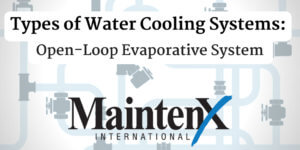
In an open-loop evaporative system, air and water are pushed through the fill material, evaporating some of the water and cooling the water that is left. Water from an outside source replaces the evaporated water, and the cycle begins again. The temperature of the cooling water is dependent on the wet bulb temperature.
Open-loop evaporative systems do not generally require expensive or complicated machinery. They are a sensible option for warm climates, with cold climates requiring additional components. There are a few exceptions to be aware of, though:
Water treatment
The main expense and hassle of this type of cooling system comes in the form of chemical treatments, which are essential to maintaining the health of your system. To keep the pipes and other components clean and functional, you need a water treatment system that can be quite intricate. Evaporative cooling systems, whether open-loop or closed loop, can run into problems when the evaporated water leaves behind contaminants. Mold, bacteria, and lime scale are some possible complications of a poorly maintained water treatment system.
To avoid lime scale and other mineral deposits, minerals in the water need to be suspended so that they don’t accumulate when the water evaporates. Keeping the water treated can also ward off corrosion. The risk of corrosion is greatest when contaminated water evaporates, leaving behind corrosive material in greater concentrations.
Cold-weather problems
Open-loop evaporative systems will require extra heating and insulation if they are exposed to freezing temperatures. This is something to consider if you are installing them in a very cold area, as freezing water only contributes to the problems caused by accumulating solids.
In general, however, open-loop evaporative systems do not require highly complex equipment, and the relative cost is affordable.

